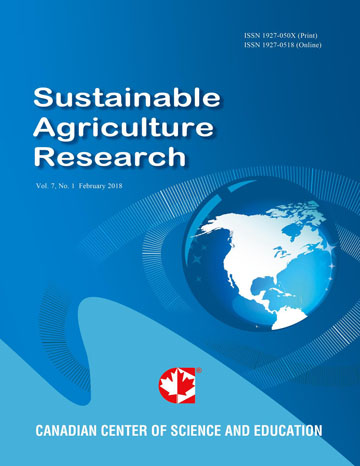Epidemic Pressure of Cassava Mosaic and Brown Streak Diseases on Ten Exotic Cassava (Manihot esculenta Crantz) Cultivars in Kisangani, DRC
- Honore Muhindo
- Lydie Empata
- Helene Banduhu
- Medard Songbo
- Benoit Dheda
- Justin Pita
- Godefroid Monde
Abstract
The crucial obstacle to cassava production in most of African countries is the diseases and pests. The present study assessed in field the epidemic pressure of Cassava mosaic disease (CMD) and Cassava brown streak disease (CBSD) on 10 exotic cassava genotypes in Kisangani. To assess the disease impact, trials were established in two sites in Kisangani, Tshopo Province in DRC. The experiment was laid out in randomized completed block design and thrice replicated. Sixty stem cuttings per variety were planted in a plot of 7 rows each measuring 25 m long. Results showed a relatively important CBSD pressure on all the ten exotic cassava genotypes tested (incidence close 60%, severity score 2 and 3.5 whiteflies/plant) and low CMD pressure (incidence 3.3%, severity score 2 and 3.5 whiteflies/plant). CMD remained relatively negligible depending on low symptom manifestation of the tested genotypes. Whitefly population varied according to the genotype and the crop age. The most abundant population was recorded on cultivar ‘Mayombe’ (17 whiteflies/plant). A negative relationship was statistically established between the abundance of whiteflies and the incidence and severity as well as for CBSD and for CMD. The production in terms of percentage of marketable tubers was (74.9%) for cultivar ‘Mayombe’, (70.3%) for ‘Obama 1’, (69.9%) for ‘Obama 2’ and (65.3%) for ‘Ngandajika’. CBSD resulted in variable yield loss on all cultivars tested. The cultivar ‘Butamu’ (85%) recorded the highest loss rate, followed by the cultivar ‘Mvuama’ (70.8%) and ‘Muzuri’ (64.3%). The yield in cassava tubers was destroyed (˂ 5 t/ha) by large necrotic spots of the brown streak in the pulp. This loss is due to the depressive of viral pandemia pressure on the output of ten exotic cassava cultivars studied in Kisangani. Our study highlighted that the best moment of harvesting cassava in Kisangani is 9 MAP, this moment would be ideal to minimize harvesting losses due to CBSD root necrosis.
- Full Text:
 PDF
PDF
- DOI:10.5539/sar.v11n4p16
Index
Contact
- Joan LeeEditorial Assistant
- sar@ccsenet.org
